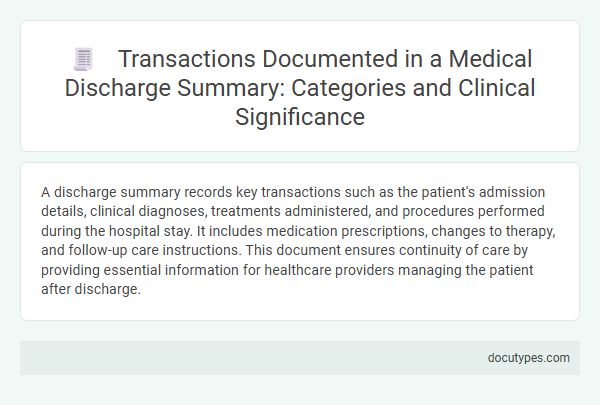A discharge summary records key transactions such as the patient's admission details, clinical diagnoses, treatments administered, and procedures performed during the hospital stay. It includes medication prescriptions, changes to therapy, and follow-up care instructions. This document ensures continuity of care by providing essential information for healthcare providers managing the patient after discharge.
Introduction to Medical Discharge Summary Transactions
A discharge summary is a critical document that outlines the medical transactions recorded during a patient's hospital stay. You can use this summary to understand the key medical events and treatments provided.
- Admission Details - Records the initial reason for hospitalization and patient's condition upon entry.
- Treatment Procedures - Documents all medical interventions, surgeries, and therapies performed.
- Medications Prescribed - Lists all medications given during the stay and those recommended after discharge.
Overview of Transaction Categories in Discharge Documentation
What types of transactions are recorded in a discharge summary? Discharge summaries document key medical and administrative transactions related to a patient's hospital stay. These include patient identification, treatments provided, medications administered, and follow-up care instructions to ensure continuity of care for you after discharge.
Admission and Discharge Information
A discharge summary records critical transactions related to a patient's hospital stay, including details of admission and discharge information. This documentation provides a clear timeline from when you were admitted to when you were discharged.
Admission information includes the reason for hospitalization, initial diagnosis, and admission date, which set the foundation for your care plan. Discharge information captures final diagnosis, treatments rendered, discharge date, and follow-up instructions essential for ongoing patient management.
Diagnostic Findings and Investigations
Discharge summaries document critical diagnostic findings and investigations completed during your hospital stay. These records provide a comprehensive overview of the medical assessments performed and their outcomes.
- Imaging Results - Includes X-rays, CT scans, MRIs, and ultrasound reports that detail anatomical and pathological findings.
- Laboratory Tests - Encompasses blood work, urine analysis, and other specimen test results that reveal biochemical and cellular information.
- Procedure Summaries - Covers diagnostic procedures such as biopsies, endoscopies, and cardiac catheterizations with findings noted.
These diagnostic transactions ensure continuity of care by informing your healthcare providers of the accurate clinical status upon discharge.
Therapeutic Interventions and Procedures
| Transaction Type | Description | Importance in Discharge Summary |
|---|---|---|
| Therapeutic Interventions | Details of all medical treatments administered during hospitalization, such as medication regimens, physiotherapy, and respiratory therapy. | Documents the ongoing care provided, guiding post-discharge management to ensure continuity and safety in Your recovery process. |
| Procedures Performed | Records all surgical and non-surgical procedures, including diagnostic tests, biopsies, catheter insertions, and wound care treatments. | Provides a clear account of invasive or diagnostic actions taken, essential for follow-up care and for healthcare providers reviewing Your medical history. |
Medication Management and Prescriptions
A discharge summary records critical transactions related to your medication management during hospital stays. It ensures continuity of care by detailing all medication-related changes and prescriptions at discharge.
- Medication Reconciliation - Lists all medications the patient was taking before admission, during hospitalization, and at discharge to avoid errors.
- New Prescriptions - Documents any new medications prescribed upon discharge, including dosages and administration instructions.
- Discontinued Medications - Identifies medications stopped during the hospital stay and confirms they should not be resumed after discharge.
Referrals and Follow-Up Instructions
Discharge summaries document critical transactions such as referrals to specialists or other healthcare providers, ensuring continuity of care beyond the hospital stay. These summaries include detailed follow-up instructions outlining medication management, therapy schedules, and necessary lifestyle adjustments. Clear recording of referrals and follow-up plans helps reduce readmission rates and supports patient recovery.
Patient Education and Counseling Documentation
Discharge summaries document various transactions related to patient care, including details of patient education and counseling. These records ensure that patients receive clear instructions about their post-discharge care, medications, and lifestyle modifications.
Patient education documentation typically includes information on medication adherence, symptom monitoring, and follow-up appointments. Counseling transactions often cover dietary recommendations, physical activity guidance, and management of chronic conditions. Accurate recording supports continuity of care and reduces the risk of readmission.
Legal and Compliance Considerations in Discharge Summaries
Discharge summaries record transactions such as patient admission details, treatments administered, diagnostic test results, and prescribed medications. Accurate documentation ensures clear communication between healthcare providers and supports patient care continuity.
Legal and compliance considerations require discharge summaries to meet regulatory standards, maintain patient confidentiality, and provide a complete account of care. You must ensure that all recorded information is precise and timely to protect both patient rights and institutional liability.
What Types of Transactions Are Recorded in a Discharge Summary? Infographic

